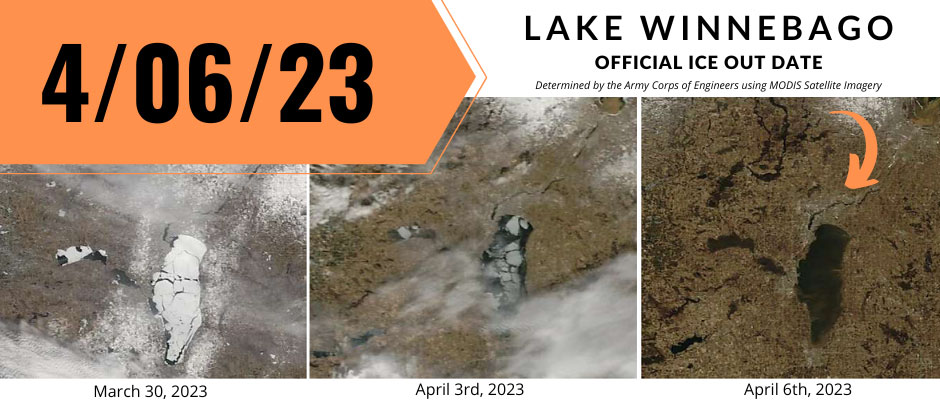Ice out on Lake Winnebago was officially called by the Army Corps of Engineers on April 6, 2023 as determined by MODIS satellite imagery. Ice out (aka ice off) is when ALL ice is gone from the lake surface as observed by satellite. This is important because ice out marks the date that the Army Corps transitions their management of Lake Winnebago from maintaining winter pool to focus on spring refill.
Ice out dates for Lake Winnebago 2006 to 2023 (Source: ACOE)

The Army Corps of Engineers – Chicago District manages water levels for Lake Winnebago by regulating outflow at the dams in Menasha and Neenah under the Federal Marshall Order of 1886. The Marshall Order is intended for flood risk management.
The Marshall Order defines the limits of regulation for Lake Winnebago:
- May 1st to October 1st (navigation season):
- High end of limit: 3.45 ft.
- Low end of limit: 0.18 ft.
- October 2nd to April 30th:
- High end of limit: 3.45 ft.
- Low end of limit: 1.68 ft
While meeting their mission of flood risk management is the priority, the Army Corps also tries to meet the needs of various stakeholders within their operating limits. This requires finding a reasonable balance among multiple competing interests. Each year, with stakeholder input, the Army Corps sets their annual regulation strategy which guides their daily management decisions.
Their annual regulation strategy represents that balance and can be broken down by certain times of the year: fall drawdown, winter pool, spring refill, and summer pool. Water level targets are set along this strategy in a schedule. These targets are listed in the Army Corps 2022 – 2023 Lake Winnebago Regulation Strategy (shown in the image below). The green band in the annual strategy represents the “target band”. The Army Corps tries to hold water levels within this band. The dotted lines represents the average lake level across all years as noted in the key.
Fall Drawdown: As of the 2021/2022 regulation strategy, fall drawdown has been scheduled to begin between Sept 1 and Oct 1 each year at the discretion of the Army Corps through an adaptive decision making process.
Winter Pool: Each February, the Army Corps evaluates basin conditions and the forecast to determine their winter drawdown target.
The Army Corps draws down Lake Winnebago every winter to reduce the risk of damage caused by ice shoves, protect shoreline properties, and provide enough space within the lake to hold excess water that flows into Lake Winnebago each spring (snow melt and rain storm runoff from a 5,900 square mile watershed). The 2023 winter drawdown target operating band for Lake Winnebago this year was 1.25 ft to 1.3 ft.
Spring refill: When the Army Corps determines ice out has occurred on Lake Winnebago based on satellite imagery, spring refill is triggered. For many boaters, people interested in habitat protection, and stakeholders working to restore the lakes, refill is of particular interest. According to the most recent annual strategy, refill targets are as follows:
- May 1st – 2.5 ft (Operating band: 2.4 to 3.6 ft)
- June 1st – 2.8 ft (Operating band: 2.7 to 3.9 ft)
- June 15th – 2.9 ft (Operating band: 2.8 to 3.0 ft)
Summer Pool: The Army Corps tries to maintain the lake within a target band for summer recreation navigation.
The total seasonal water elevation change is typically about 1.8 ft in a given year.
Recent conditions:
Despite having all available gates open at the dams since March 6, 2023, the average level of Lake Winnebago has been well above the target band since the beginning of April. This is likely due to the lake not being drawn down far enough or early enough to accommodate spring runoff from snow melt and precipitation. When inflows to Lake Winnebago exceed outflow capacity of the gates, the lake begins to rise uncontrolled. Overshooting the target band increases risk of flooding, significantly damages habitat and limits water quality restoration gains (among other impacts).
A graph from April 21, 2023 shows the recent average lake level (dashed line). Hopefully, precipitation will ease up and the Army Corps will be able to regain control before too much damage is done to the wetlands and aquatic habitat.

Additional Water Level Related Information:
1.) Water Level Management for the Winnebago Waterways: This report describes water level management including the process of developing an annual strategy, the considerations for the strategy, and the reason the strategy (schedule) is in its current form. CLICK HERE for the report.
This report is part of a larger planning effort for the Winnebago Lakes. The rest of the lake plan can be found here: https://fwwa.org/lake-management-planning-2/
2.) Winnebago Water Level Assessment Team (WWLAT): This is a stakeholder group that holds discussions about water levels independent of the Army Corps public input process. The website for the Team provides information about the background, past recommendations, and more. Interested stakeholders are welcome to participate. Link: https://fwwa.org/winnebago-waterways/wwlat/
3.) The Army Corps provides access to a lot of data and information through their Lake Winnebago webpage: CLICK HERE
Winnebago Waterways is a Fox-Wolf Watershed Alliance recovery initiative. Contact us at wwinfo@fwwa.org





